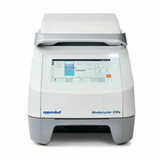

Product Overview
- Innovative 2D-Gradient for advanced PCR optimization
- Heating rate: 5 C/s
- Block temperature accuracy: ±0.15 C
- Intuitive touch display
- Connect up to 10 units to a network
- flexlid concept: automatic height adjustment of the lid allows you to use all types of consumables
- Small footprint
- 2 year warranty
Technical Specifications
| Unit Can Control 9 Other Units In Network | ■ |
| Unit Can Only Be Controlled | – |
| Thermoblock | Aluminum |
| Sample Capacity | 96-well plate or 0.1/0.2 mL tubes |
| 96-well Plate | ■ |
| 384-well Plate | – |
| 0.1/0.2 Ml Tubes | ■ |
| Heating Technology | Six peltier elements |
| 2D-Gradient Block | over 12 columns/over 8 rows |
| Temperature Control Mode | Fast, Intermediate, Standard, Safe |
| Temperature Control Range Of the Block | 4 – 99 °C |
| Gradient Range | 1 – 30 °C |
| Gradient Temperature Control Range | 30 – 99 °C |
| Block Homogeneity 20 – 72 °C | ≤±0.2 °C |
| Block Homogeneity 95 °C | ≤±0.3 °C |
| Control Accuracy | ±0.15 °C |
| Product Type | PCR |
| Heating Rate | max. 5 °C/s |
| Cooling Rate | max. 2.3 °C/s |
| Lid Descent | flexlid® technology with TSP |
| High Pressure Lid | – |
| Lid Temperature Range | 37 – 110 °C |
| Interfaces | Ethernet, USB |
| Power Supply | 110 – 230 V, 50 – 60 Hz |
| Max. Power Consumption | 850 W |
| Total Weight | 11.5 kg |
| Dimensions (W x D x H) | 27.5 × 43 × 33 cm / 10.8 × 16.9 × 13 in |
| Remote Device Monitoring and Notifications (visionize®) | VisioNize® touch enabled |
| Touchscreen Interface | yes |
Technical Documents
- 001 – Correct Temperature? – Yes!
- Interview Henner Tasch
- Master of Class
- Never Been Easier
- Simple, Central, Smart
- The Next Stage
- VisioNize Lab Suite Cycler Flyer
- Your NGS–Upgraded
- Lithium cell AI module
- Mastercycler control panel
- Mastercycler nexus/X50
- Mastercycler X50
- CycleManager X50
- Mastercycler X50
- VisioNize® Lab Suite Connectivity Guide - Mastercycler
- 387 – Ultimate PCR Optimization with Eppendorf Mastercycler ® X50 2D gradient
- 388 – Highly reproducible low volume PCR with Mastercycler® X50 and epMotion®
- 400 – Reduced PCR runtimes and increased yields using Eppendorf Fast PCR Consumables
- 418 – 2D-Gradient in Multiplex PCR for Meat Species Identification
- 423 – Using the Mastercycler® X50 and Its 2D-Gradient to Increase Yield and Specificity of Your PCR
- 424 – Long-Range PCR Optimization with Eppendorf Mastercycler® X50
- 446 – Breaking Barriers: Endpoint PCR in 15 Minutes or Less (Note: Kit available in EU & North America only)
- 455 – Very Low Noise Generation of High Performing Mastercycler® X50
- 461 – Easy Migration of PCR Protocols Using Eppendorf’s Automated Runtime Adjustment
- Mastercycler X50
- Reproducibility and Speed in PCR
- Sample Preparation in Microbiome Analysis
Detailed Description
Speed and enhanced PCR optimization functions like the 2D-Gradient make the Mastercycler X50 the ideal PCR cycler for advanced research in molecular biology. The excellent block temperature regulation gives rise to the next stage of PCR reproducibility, whereas the adaptable user management and profound documentation capabilities give peace of mind to laboratories working to set standards. A highly intuitive touch display, low noise levels, low power consumption, and the versatile flexlid® concept complete the product to be a powerful PCR cycler. Up to 10 PCR cyclers can be combined - ideal for high throughput applications or labs with a high number of users running different assays. Should you feel you need more flexibility or throughput, up to 50 PCR cyclers can be combined in a computer-controlled network.
2D-Gradient allows you to optimize both the denaturation temperature (bottom to top) and the annealing temperature (left to right) during the same run. Higher denaturation temperatures can have the advantage of increased specificity while lower denaturation temperatures reduce stress on biomolecules and can lead to increased yield. Assays that struggle to work reliably at a 95° denaturation temperature could benefit significantly from the optimization of the denaturation temperature.
2D-Gradient allows you to optimize both the denaturation temperature (bottom to top) and the annealing temperature (left to right) during the same run. Higher denaturation temperatures can have the advantage of increased specificity while lower denaturation temperatures reduce stress on biomolecules and can lead to increased yield. Assays that struggle to work reliably at a 95° denaturation temperature could benefit significantly from the optimization of the denaturation temperature.
Need help?
Call our product expert?
+1.800.789.5550
or
Contact Us
7:00am - 5:00pm PST
Monday - Friday
!

